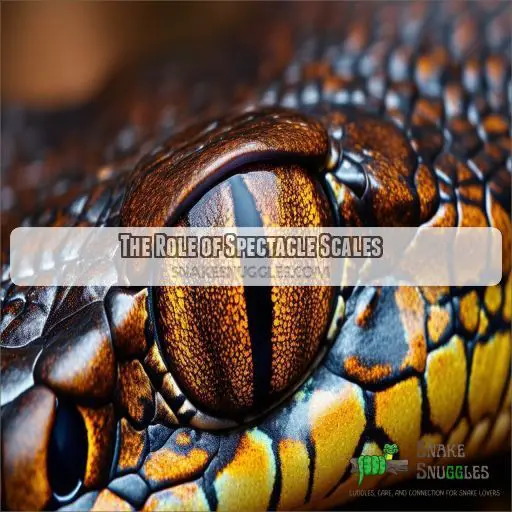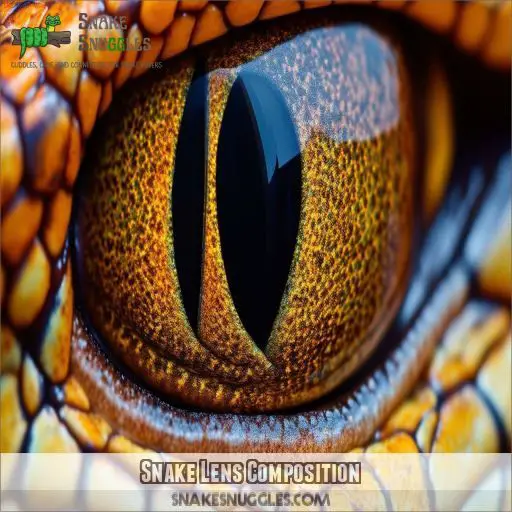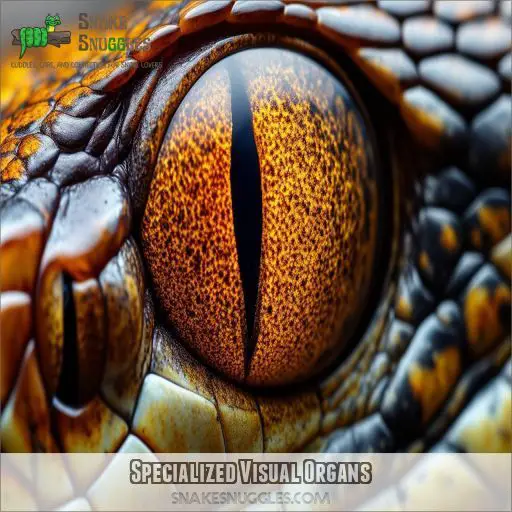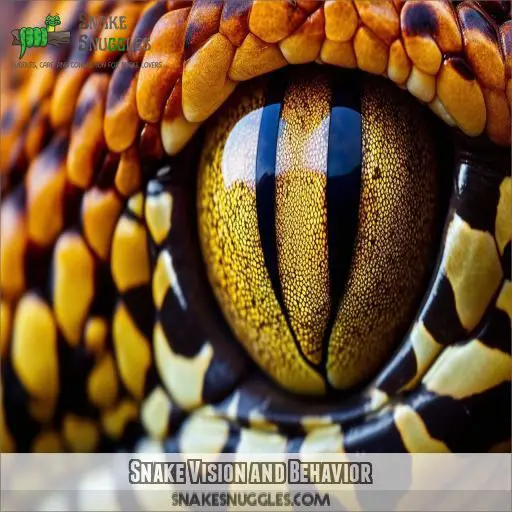This site is supported by our readers. We may earn a commission, at no cost to you, if you purchase through links.

Snakes have evolved some unique ways of perceiving their environment, and we’re here to uncover the secrets of their slithery sight.
How do snakes see light? Let’s find out.
Table Of Contents
- Key Takeaways
- How Do Snakes See Light?
- Snake Eye Anatomy
- The Role of Spectacle Scales
- Snake Lens Composition
- The Function of Retina Cells
- Specialized Visual Organs
- Snake Vision and Behavior
- Frequently Asked Questions (FAQs)
- How does a snake eye interpret light?
- Can snakes see in low light?
- Do snakes see color?
- How do snakes focus their eyes?
- What does a snake’s vision look like?
- How do snakes respond to light?
- How do snakes see in the dark?
- Can a snake see an object?
- How do snakes see in the dark?
- What colours can snakes see?
- Can snakes see UV light?
- How does infrared vision work?
- Do snakes have eyes on top of their heads?
- Conclusion
Key Takeaways
- Snake eyes are protected by transparent spectacle scales, which also get shed to maintain clear vision.
- Their spherical lenses provide a sharper focus, and they have more rod cells than cone cells, making them sensitive to light, movement, and some colors.
- Snakes possess pit organs that detect infrared radiation, allowing them to sense heat and locate warm-blooded prey in low-light conditions.
- With a combination of rod and cone cells, snakes can see in dim and bright light, and their unique eye anatomy contributes to their exceptional hunting and defensive capabilities.
How Do Snakes See Light?
The unique features of snake eyes, including spectacle scales, specialised lenses, and retina cells, enable them to detect light effectively. Their eyes are protected by transparent spectacle scales, ensuring clear vision. The spherical shape of their lenses provides sharper focus, enhancing their swift movement.
The snake retina is where light detection truly comes into play. Comprised of both rod and cone cells, it’s responsible for their visual perception. The majority of their rod cells enhance light sensitivity, especially in low-light conditions, allowing them to detect movement and locate prey. Cone cells, though fewer in number, contribute to colour perception and visual clarity.
If you’re curious about how these features evolved and benefit snakes, there’s more to uncover about their fascinating visual system.
Snake Eye Anatomy
Snakes are unique in their anatomy and function.
Unlike humans, snakes lack eyelids, but that doesn’t mean their eyes are unprotected. Nature has provided them with a clever alternative: transparent spectacle scales**.
These scales act as a protective barrier, shielding their eyes from potential harm. And just like snakes shed their skin through the molting process, these spectacle scales are also shed, ensuring fresh and clear vision.
This scale shedding is similar to how we might clean our glasses or contacts to improve our eyesight.
Snake eyes are designed for great vision, with lenses that are more spherical than ours, granting them sharper focus and a unique perspective on the world around them.
While we may not see eye to eye with snakes, their visual system is finely tuned to their hunting and survival needs.
The Role of Spectacle Scales
Now, let’s take a closer look at the role of spectacle scales in snake vision.
Spectacle scales are transparent, protective coverings that act as "eyelids" for snakes, as they lack eyelids themselves. These scales are essential for maintaining eye health and clarity.
- One of their critical functions is to provide protection for the snake’s eyes.
- Spectacle scales are subject to shedding, similar to other snake scales, ensuring that the snake’s vision remains unobstructed.
- The shedding frequency of these scales can impact the snake’s eyesight, as a buildup of old scales may obscure their vision.
Snake Lens Composition
Snake lenses are fascinating components of their visual system. Unlike human lenses, snake lenses are more spherical in shape, which gives them a sharper focus. This unique lens shape is a key factor in how snakes see the world around them.
| Lens Feature | Description |
|---|---|
| Shape | Spherical, allowing for sharper focus |
| Focus | Ability to detect light and movement |
| Clarity | Higher visual acuity in arboreal and diurnal snakes |
| Function | Essential for hunting and predator avoidance |
The shape of a snake’s lens is a result of snake vision evolution, with nature ensuring that their lenses are optimized for their specific needs and environments.
The Function of Retina Cells
Snake retinas contain both rod and cone cells, which help them detect light and color. However, most snake species have more rod cells, making them sensitive to light and movement but not color.
Rod Cells
Snake retinas contain rod cells, which enhance their light sensitivity, especially in low-light conditions. This feature is essential for night hunting, allowing snakes to detect movement and locate prey. With a majority of rod cells, snakes have excellent visual acuity for light and dark contrast, making up for their limited colour perception.
Cone Cells
Cone cells play a big role in snake vision, especially when it comes to seeing colors and getting a clear picture of the world. While most snakes have fewer cone cells compared to rod cells, these specialized cells in the retina contribute to their overall vision:
- Color Perception: Cone cells allow snakes to see colors, even though their color vision isn’t as good as ours.
- Vision Clarity: These cells also help snakes see things sharply and in detail.
- Light Sensitivity: Cone cells help snakes adjust to different lighting conditions.
- Evolutionary Role: The fact that snakes have cone cells points to how they’ve evolved to fit their environment and hunting habits.
Specialized Visual Organs
Some snakes have a secret weapon for hunting in the dark. They possess a specialized visual organ, the pit organ, which allows them to detect infrared radiation and sense heat.
Pit Organs and Infrared Detection
Some snakes have a secret weapon: infrared detection. They possess specialized organs, called pit organs, located between their eyes and nostrils. These pit organs allow snakes to sense infrared radiation and temperature differences as small as 0.003 degrees Celsius. This means they can effectively "see" heat, which is incredibly useful for hunting warm-blooded prey in low-light conditions.
Nocturnal Adaptations
As night hunters, snakes have evolved several adaptations to navigate and hunt effectively in low-light conditions.
Their pit organs, located between their eyes and nostrils, are key to their nocturnal lifestyle.
These organs enable infrared sensing, allowing snakes to detect heat and locate warm-blooded prey in the dark.
This thermal vision is a major advantage for hunting and predator avoidance.
Without the UV filter found in day-hunting snakes, night hunters can see better when UV radiation is dominant.
Snake Vision and Behavior
Snake vision influences their hunting and defensive strategies. Ambush predators rely on camouflage and stillness, often using heat-sensing pit organs, while active hunters like colubrids have sharper vision for tracking. Vision also plays a role in defence, with some snakes using visual threat displays like rattling or hooding.
Hunting Strategies
Snake vision and behavior are closely intertwined, with their visual capabilities shaping their hunting strategies. Snakes employ a variety of techniques to capture their prey:
- Ambush Predators: These snakes rely on camouflage and stillness, often utilizing pit organs to detect heat and locate warm-blooded prey.
- Active Hunters: Some snakes, like colubrids, have well-developed sight for tracking and pursuing prey.
- Visual Threat Displays: Snakes often use visual displays, such as rattling or hooding, to deter potential threats.
Defense Mechanisms
Snakes have developed a range of defense mechanisms to protect themselves from predators.
Their ability to camouflage is well-known, blending seamlessly into their surroundings.
They also use mimicry, adopting shapes and patterns that resemble dangerous or venomous species, deterring potential threats.
When faced with danger, snakes employ visual threat displays, such as rattling or hooding, to warn intruders.
These defensive behaviors, combined with their venomous capabilities, make snakes formidable opponents, ensuring their survival in the wild.
Frequently Asked Questions (FAQs)
How does a snake eye interpret light?
Snake eyes interpret light through retinas with rod and cone cells. Spherical lenses provide sharper focus than human eyes. However, fewer cone cells impair color and detail perception.
Can snakes see in low light?
Yes, snakes can see in low light conditions. Snakes are sensitive to UV light, which allows them to see well in the dark.
Do snakes see color?
Snakes can see some colours, such as blues, greens, and yellows. Their red vision is less developed. They’re likely to be dichromatic in daylight, meaning they see two primary colours compared to the three that humans see.
How do snakes focus their eyes?
Snakes focus their eyes by moving their lens forward or backward, unlike most tetrapods, which focus by changing the curvature of the lens.
What does a snake’s vision look like?
Snakes see the world in shades of blue and green, with some species evolving to see ultraviolet light as well. They’ve a special organ that detects infrared radiation, allowing them to sense heat and locate warm-blooded prey.
How do snakes respond to light?
Snakes respond to light in various ways, depending on their species and environment. Some exhibit light-induced aggression, becoming defensive or territorial under certain light conditions. Others use light to locate prey through shadows, movement patterns, or color differentiation. Snakes have specialized photoreceptor cells that detect UV light, aiding navigation and communication.
How do snakes see in the dark?
Like a cat prowling in the shadows, snakes navigate the darkness with a unique set of tools. They rely on their keen senses, including infrared "vision," scent detection, and vibrational sensitivity, to hunt and survive. Infrared "vision" is key, with pit organs detecting infrared radiation and temperature changes as small as 003 degrees Celsius.
Can a snake see an object?
Yes, snakes can see objects, but their vision is very different from ours. They see the world in black and white and can only make out the shapes of objects. They’ve good close-up vision but struggle to see faraway objects.
How do snakes see in the dark?
Snakes with pit organs can detect infrared radiation, which they convert into electrical signals, allowing them to see in the dark. They can detect temperature differences as small as 003 degrees Celsius.
What colours can snakes see?
Snakes can see some colours, including blues and greens, and potentially some reds. Their vision extends into the ultraviolet spectrum.
Can snakes see UV light?
Snakes can see UV light. Snakes that hunt during the day have a UV filter, while night-hunting snakes do not.
How does infrared vision work?
Infrared vision in snakes relies on their pit organs, which detect infrared radiation and temperature changes. The pit organ’s membrane converts thermal changes into electrical signals, which are then sent to the optic tectum of the brain for processing.
Do snakes have eyes on top of their heads?
Some snakes have eyes on the tops of their heads, giving them better overhead vision. Most, however, have eyes on the sides of their heads, which limits their field of view.
Conclusion
So, how do snakes see light? Well, it turns out they’ve a pretty impressive visual system. From their unique eye anatomy to their specialized cells and organs, snakes can perceive their environment in ways we’re still uncovering. Their eyes are protected by spectacle scales, and their lenses are composed of unique proteins that contribute to their exceptional vision.
With a combination of rod and cone cells, they can detect movement and see in both dim and bright conditions. And that’s not all — snakes have pit organs that detect infrared radiation, allowing them to sense the body heat of their prey. All these adaptations come together to make snakes highly effective hunters and defenders.












